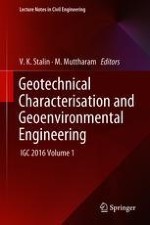2019 | OriginalPaper | Chapter
Biominerlisation as a Remediation Technique: A Critical Review
Authors : Surabhi Jain, D. N. Arnepalli
Published in: Geotechnical Characterisation and Geoenvironmental Engineering
Publisher: Springer Singapore
Activate our intelligent search to find suitable subject content or patents.
Select sections of text to find matching patents with Artificial Intelligence. powered by
Select sections of text to find additional relevant content using AI-assisted search. powered by
